全文HTML
--> --> -->经验学习特性在多篇STM→LTM忆阻器实验研究文献中有过多次报道[21-30]. 图1给出观察经验学习特性的“学习-遗忘-再学习”实验过程的示意说明, 其中, 图1(a)为该实验中所施加的电压, 图1(b)—图1(d)给出忆阻器记忆在该实验的不同阶段的变化情况. 在初次学习阶段, 如图1(b)所示, 连续脉冲激励作用下忆阻器记忆逐渐形成; 在遗忘阶段, 如图1(c)所示, 作用在忆阻器上的脉冲激励被移除, 忆阻器的短期记忆逐渐被遗忘; 当再次施加脉冲激励, 如图1(d)所示, 忆阻器的记忆恢复到遗忘之前的状态所经历的脉冲数量明显比初次学习阶段形成相同的记忆所经历的脉冲数量更少.
 图 1 “学习-遗忘-再学习”实验过程的示意说明 (a) 实验各个阶段施加在忆阻器上的电压; (b)?(d) 依次为初次学习过程、遗忘过程、再次学习的记忆恢复过程中忆阻器记忆的变化情况, 横坐标中NL, tf, NR分别表示初次学习的脉冲数量、遗忘过程的时长、再次学习的记忆恢复过程所经历的脉冲数量
图 1 “学习-遗忘-再学习”实验过程的示意说明 (a) 实验各个阶段施加在忆阻器上的电压; (b)?(d) 依次为初次学习过程、遗忘过程、再次学习的记忆恢复过程中忆阻器记忆的变化情况, 横坐标中NL, tf, NR分别表示初次学习的脉冲数量、遗忘过程的时长、再次学习的记忆恢复过程所经历的脉冲数量Figure1. Illustration of “learning-forgetting-relearning” experiment: (a) The applied voltage in each period of this experiment; (b)?(d) the change of memristor memory during the first learning process, forgetting process, and the memory recovery period of relearning process, respectively. NL, tf, and NR stand for the number of applied pulses in the first learning process, the forgetting time, and the number of applied pulses in the memory recovery period of the relearning process, respectively.
文献[31-36]对STM→LTM忆阻器的数学模型给出讨论. 文献[31]在文献[37]所设计的具有遗忘特性的忆阻模型的基础上, 根据STM→LTM忆阻器实验研究中所报道的短期、长期记忆现象, 设计了STM→LTM忆阻模型, 该模型的设计并没有考虑经验学习特性. 文献[32-34]对文献[31]中所设计的STM→LTM忆阻模型在“学习-遗忘-再学习”实验中的特性给出仿真分析, 认为该模型同时也能够描述经验学习特性. 文献[35]在对上述模型的分析中发现, 该模型的部分特性(包括该模型所描述的经验学习特性)与STM→LTM忆阻器实验研究中所报道的相关现象并不完全一致, 其中, 在经验学习特性方面, 并不是所有的STM→LTM忆阻器的实验研究中都报道了“学习-遗忘-再学习”实验的现象, 即由已报道的实验研究文献并不能得出经验学习特性是STM→LTM忆阻器的固有特性这一结论, 另外, 该模型在“学习-遗忘-再学习”实验中的仿真结果与已报道的这类忆阻器的经验学习特性并不完全相同, 文献[35]重新设计了STM→LTM忆阻器的数学模型, 并在新模型的基础上通过将模型中的一个参数重新定义为新状态变量, 设计得到具有经验学习特性的STM→LTM忆阻模型, 该模型能够更好地描述这类忆阻器的实验研究中所报道的实验现象. 文献[36]在文献[35]中模型的基础上, 对于存在感觉记忆现象的STM→LTM忆阻模型给出设计, 并对模型状态变量的物理意义给出讨论.
文献[32-34]中所报道的STM→LTM忆阻模型在“学习-遗忘-再学习”实验中的仿真结果虽然与相关实验研究所报道的经验学习特性并不完全一致, 但仿真结果所反映的应该是文献[31]中的STM→LTM忆阻模型的固有特性, 将该特性称为“较快速再次学习特性”. 尚未看到有文章对文献[35]中的不考虑经验学习特性的STM→LTM忆阻模型在“学习-遗忘-再学习”实验中的特性给出讨论; 文献[32-34]中之所以将“较快速再次学习特性”认为是“经验学习特性”, 是因为两特性的实验过程相同, 实验现象也相似, 这两个特性的关系尚未给出讨论; 文献[36]仅对文献[35]的模型中与短期、长期记忆现象相关的状态变量的物理意义给出分析, 并没有讨论该模型中与经验学习特性相关的状态变量的物理意义.
本文将对文献[35]所提出的STM→LTM 忆阻模型在“学习-遗忘-再学习”实验中的特性给出进一步分析. 本文首先对文献[35]中的STM→LTM 忆阻模型给出介绍, 然后对于不考虑经验学习特性的STM→LTM忆阻模型在“学习-遗忘-再学习”实验中的特性给出分析, 以验证较快速再次学习特性确实是STM→LTM忆阻模型的固有特性; 对于具有经验学习特性的STM→LTM忆阻模型中的参数对遗忘之后再次学习的记忆恢复速度的影响给出分析, 并根据分析结果对“较快速再次学习特性”和“经验学习特性”的关系给出讨论; 最后对模型中与经验学习特性相关的状态变量的物理意义给出分析.
上述STM→LTM忆阻模型中, wmax的定义决定了模型所描述的忆阻器是否具有经验学习特性: 若wmax为常数1, 则模型所描述的忆阻器无经验学习特性; 若wmax∈[w,1]为状态变量, 其状态方程为
模型中, 状态变量w的大小反映了忆阻器的记忆状态. 在w的状态方程(2)式中, w的变化方向和变化的快慢分别由Fw和Tw所描述. 图2给出wmin和τw0取不同值时Fw和Tw关于V的曲线. 在“学习-遗忘-再学习”实验中, 作用在忆阻器上的电压始终满足V ≥ 0 V. 当作用在忆阻器上的电压较大时(例如脉冲激励作用阶段), Fw ≈ wmax, Tw ≈ τw+, wmax, τw+均为常数, 此时w的变化情况主要与w当前的大小有关. 当作用电压较小时(例如脉冲间隔期间), Fw ≈ wmin, Tw ≈ τw 0, 由状态方程(3)式和(4)式可知, wmin和τw 0的大小与以往作用在忆阻器上的电压有关, 因此脉冲间隔期间w的变化情况不仅与w本身的大小有关, 同时还会受wmin和τw 0的大小的影响. 图3给出w初值和输入电压V一定, wmin和τw 0取不同常数时, 状态变量w在一个脉冲周期内的变化情况, 仿真中a+ = 2 V–1, b+ = 35, τw+ = 0.1 s, 所施加脉冲信号的脉冲作用时间和脉冲间隔时间均为0.05 s, 脉冲和脉冲间隔期间作用在忆阻器上的电压大小分别为1和0.1 V, 仿真初始时刻w = 0.5. 由图3给出的仿真结果可以看出, wmin和τw 0的改变对脉冲作用阶段状态变量w的变化情况的影响并不明显, 而对脉冲间隔期间w的变化情况会有明显影响: wmin, τw 0越大, w在脉冲间隔期间的遗忘过程越慢.
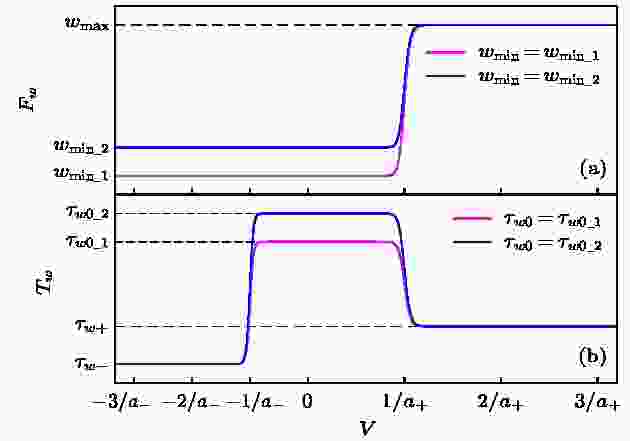 图 2 (a) Fw和 (b) Tw关于V的曲线, b+ = b– = 35
图 2 (a) Fw和 (b) Tw关于V的曲线, b+ = b– = 35Figure2. Curves of (a) Fw and (b) Tw with respect to V, b+ = b– = 35.
 图 3 wmin和τw 0的大小对状态变量w在一个脉冲周期内的变化情况的影响 (a) τw 0 = 0.2 s, wmin取值为不同常数时w的变化情况; (b) wmin = 0.2, τw 0取值为不同常数时w的变化情况
图 3 wmin和τw 0的大小对状态变量w在一个脉冲周期内的变化情况的影响 (a) τw 0 = 0.2 s, wmin取值为不同常数时w的变化情况; (b) wmin = 0.2, τw 0取值为不同常数时w的变化情况Figure3. Variation of w within a pulse period when wmin and τw 0 take different values: (a) Variation of w when τw 0 = 0.2 s and wmin takes different values; (b) variation of w when wmin = 0.2 and τw 0 takes different values.
“学习-遗忘-再学习”实验中, 在初次学习阶段, 作用在忆阻器上的脉冲激励会使得w, wmin, τw 0均逐渐递增; 在遗忘阶段, w逐渐递减至wmin, 而wmin和τw 0无明显变化; 在再次学习阶段状态变量wmin和τw 0均比初次学习阶段更大, 因此再次学习阶段的脉冲间隔期间w的遗忘速度比初次学习阶段更慢, 故与初次学习阶段相比, 再次学习阶段的每个脉冲周期内w的增长量更大, 记忆增量一定时所需经历的脉冲数量更少.
由图3给出的仿真结果还可以看出, 状态变量w在脉冲间隔期间的遗忘量随wmin的增大而均匀递减; 该遗忘量也会随τw 0的增大而逐渐递减, 但递减量随τw 0的增大而逐渐减小. 这是由于状态方程(2)中,

























图4给出τw 0的初值不同的两组“学习-遗忘-再学习”过程仿真结果. 仿真中a+ = 2 V–1, b+ = 35, τw+ = 0.1 s, τmin+ = 0.3 s, τmin0 = 105 s, k = 0, kτ+ = 5, 由于仿真中的作用电压始终非负, 因此参数a–, b–, τw–, τmin–, kτ–可取任意值; 初始时刻, 模型的各个状态变量均处于其下限; 所施加电压脉冲幅值和脉冲间隔的电压大小分别为1和0.1 V, 脉冲宽度和间隔的时长分别为0.005和0.05 s. 两组仿真在初次学习阶段均经历10个脉冲激励. 当τw 0初值为0.01 s时, 如图4(a)所示, 再学习阶段的记忆恢复仅需经历5个脉冲; 当τw 0初值为1 s时, 如图4(b)所示, 再学习阶段的记忆恢复需经历9个脉冲.
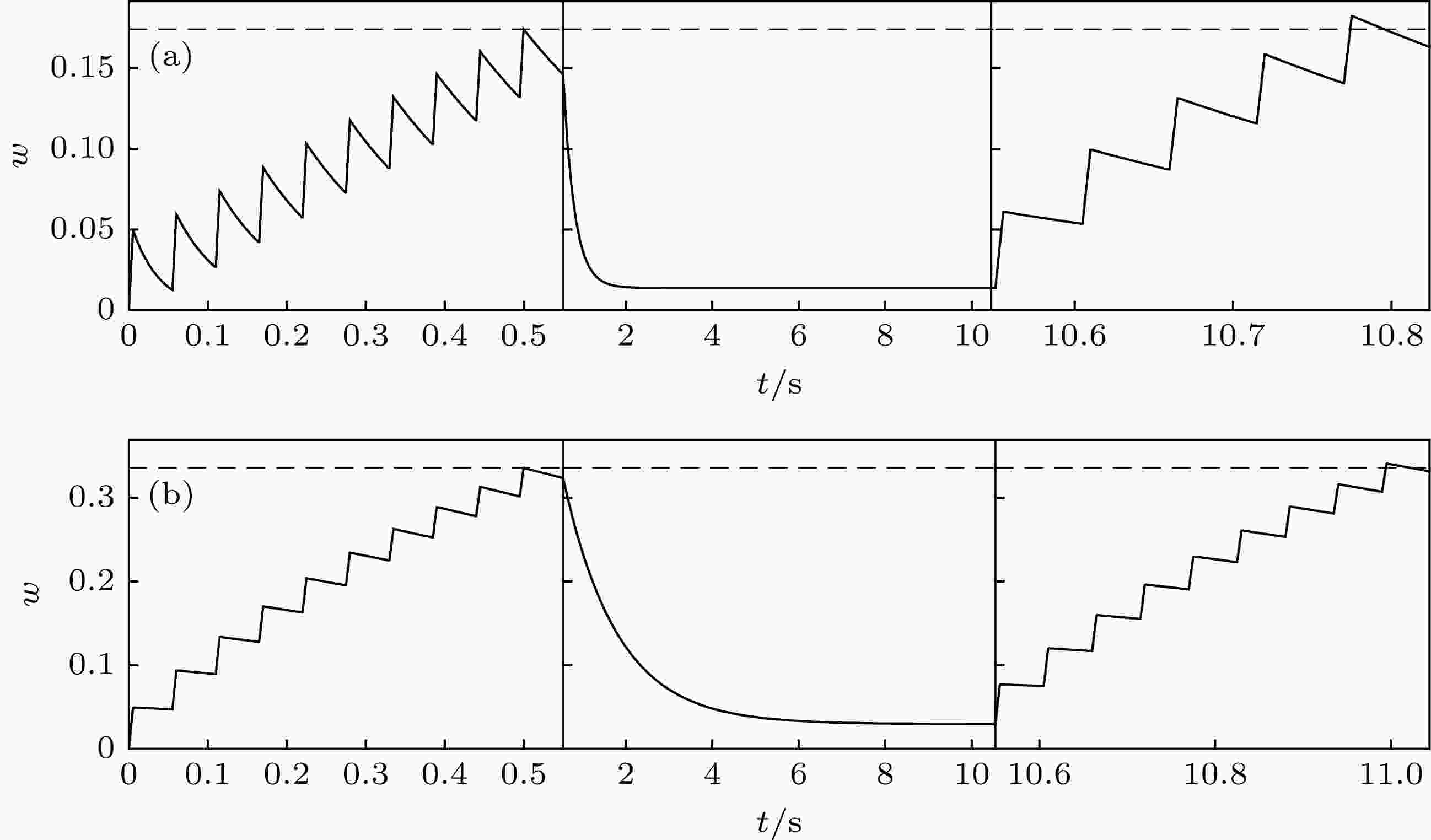 图 4 状态变量τw 0的初值大小对于“学习-遗忘-再学习”过程中w的变化的影响, 虚线标明初次学习阶段w所达到的最大值(a) τw 0初值为0.01 s; (b) τw 0初值为1 s
图 4 状态变量τw 0的初值大小对于“学习-遗忘-再学习”过程中w的变化的影响, 虚线标明初次学习阶段w所达到的最大值(a) τw 0初值为0.01 s; (b) τw 0初值为1 sFigure4. Influence of the initial value of τw 0 on the variation of w in “learning-forgetting- relearning” process. The maximum value of w during the first learning period is marked by a dashed line: (a) The initial value of τw 0 is 0.01 s; (b) the initial value of τw 0 is 1 s.
由上述分析可以看出, 上一节介绍的STM→LTM忆阻模型当wmax为常数1时具有较快速再次学习特性是因为在脉冲激励过程中状态变量wmin和τw 0会逐渐递增, wmin的递增描述了忆阻器有更多的长期记忆形成, τw 0的递增描述了忆阻器遗忘曲线的时间常数逐渐增大, STM→LTM忆阻器的长期记忆和遗忘曲线时间常数随脉冲激励而逐渐增大的现象在这类忆阻器的实验研究中均有所报道[1-30], 因此, 较快速再次学习特性是STM→LTM忆阻器的固有特性.
状态变量wmax限定了w增长的上限, 因此w在脉冲激励作用时的增长过程将受到wmax的大小的影响. “学习-遗忘-再学习”实验过程中, 在初次学习阶段, w和wmax比较接近, w的增长会受到wmax的限制; 在遗忘阶段, w减小至wmin, 而wmax并无明显变化; 之后的再学习阶段的初期, 由于wmax明显大于w, 此时wmax对于w的增长的限制较小, 因此w将以更快的增速恢复至遗忘之前的状态, 当w逐渐接近wmax后, w的增速将再次受到wmax的限制. 另外, 由于初次学习阶段wmin也有所增长, 因此在再次学习阶段的记忆恢复过程中, w增长的“起点”更高; 由上一节中的分析可知, wmin和τw 0增长会使得w在脉冲间隔期间遗忘得更慢. 这两方面因素也会使得记忆恢复所经历的脉冲数量更少.
已报道的这类忆阻器的“学习-遗忘-再学习”实验中, 不同材料的忆阻器在该实验遗忘过程的记忆遗忘量以及再学习阶段的记忆恢复速度均有所不同. 表1给出文献[21-30]所报道的“学习-遗忘-再学习”实验中的相关数据.
| 初次学习 脉冲数量 | 记忆遗忘量a) | 记忆恢复 脉冲数量 | |
| 文献[21] | 80 | ~50% | 4 |
| 文献[22] | 50 | ~35% | 7 |
| 文献[23] | 80 | ~80% | 12 |
| 文献[24] | 50 | ~80% | 20 |
| 文献[25] | 30 | ~80% | 20 |
| 文献[26] | 50 | ~75% | 25 |
| 文献[27]b) | 40 | ~60%, ~40% | 9, 4 |
| 文献[28]b) | 40 | ~50%, ~40% | 16, 6 |
| 文献[29]b) | 50 | ~40%, ~30%, ~29%, ~20% | 18, 12, 8 |
| 文献[30]b) | 50 | ~80%, ~55%, ~25% | 25, 12, 5 |
| a) “记忆遗忘量”是根据各个文献中所报道的“学习-遗忘-再学习”实验的遗忘曲线, 对于记忆的遗忘量占初次学习所形成的记忆总量的比例给出估计, 各个数据前的“~”表示该数据是根据实验曲线所得的估计值. b) 在文献[27—30]所报道的实验中经历了多次“遗忘”与“再学习”过程, 表中对这几篇文献依次给出每次遗忘过程的遗忘比例, 以及每次再学习阶段的记忆恢复所经历的脉冲数量. | |||
表1文献[21—30]中所报道的“学习-遗忘-再学习”实验数据
Table1.Experimental data of “learning-forgetting-relearning” experiment in References [21—30].
模型中的状态变量w, wmin, wmax在脉冲电压作用时的最大增速分别由各自状态方程中的参数τw+, τmin+, τmax+所描述. 图5—图7给出参数τw+, τmin+, τmax+大小的改变对于“学习-遗忘-再学习”实验中状态变量w, wmin, wmax的变化情况的影响, 仿真中除了参数τw+, τmin+, τmax+以外, τw 0_min = 0.1 s, kτ+ = 50, τmax 0 = 105 s, 其他模型参数以及所施加的脉冲参数与图4仿真中的参数取值相同. “学习-遗忘-再学习”实验中忆阻器依次经历: 30个脉冲的初次学习、100 s的遗忘过程、30个脉冲的再次学习. 仿真初始时刻的各个状态变量均处于其下限. 在初次学习阶段w所达到的最大值在图中用虚线标出.
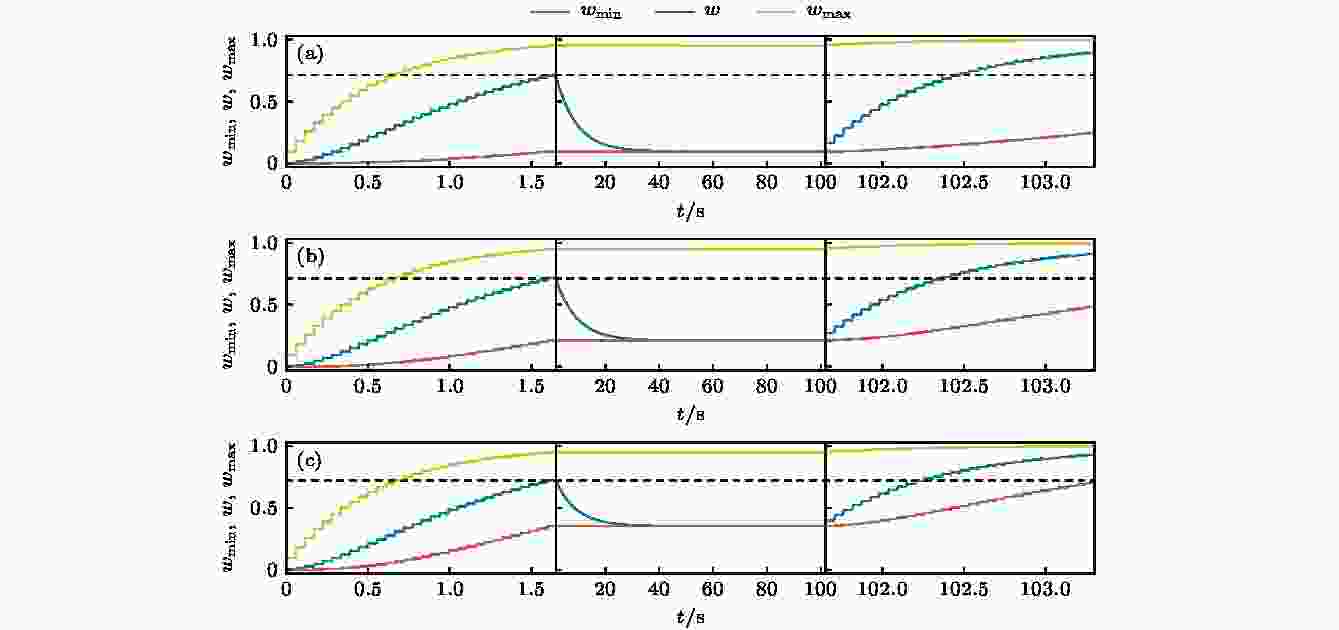 图 5 τw+ = 0.06 s, τmax+ = 0.05 s, τmin+取不同值时的“学习-遗忘-再学习”实验仿真结果 (a) τmin+ = 0.5 s; (b) τmin+ = 0.2 s; (c) τmin+ = 0.1 s. 虚线标出w在初次学习阶段所达到的最大值
图 5 τw+ = 0.06 s, τmax+ = 0.05 s, τmin+取不同值时的“学习-遗忘-再学习”实验仿真结果 (a) τmin+ = 0.5 s; (b) τmin+ = 0.2 s; (c) τmin+ = 0.1 s. 虚线标出w在初次学习阶段所达到的最大值Figure5. Simulations of “learning-forgetting-relearning” process when τw+ = 0.06 s, τmax+ = 0.05 s, and τmin+ takes different values: (a) τmin+ = 0.5 s; (b) τmin+ = 0.2 s; (c) τmin+ = 0.1 s. The maximum value of w during the first learning period is marked by a dashed line.
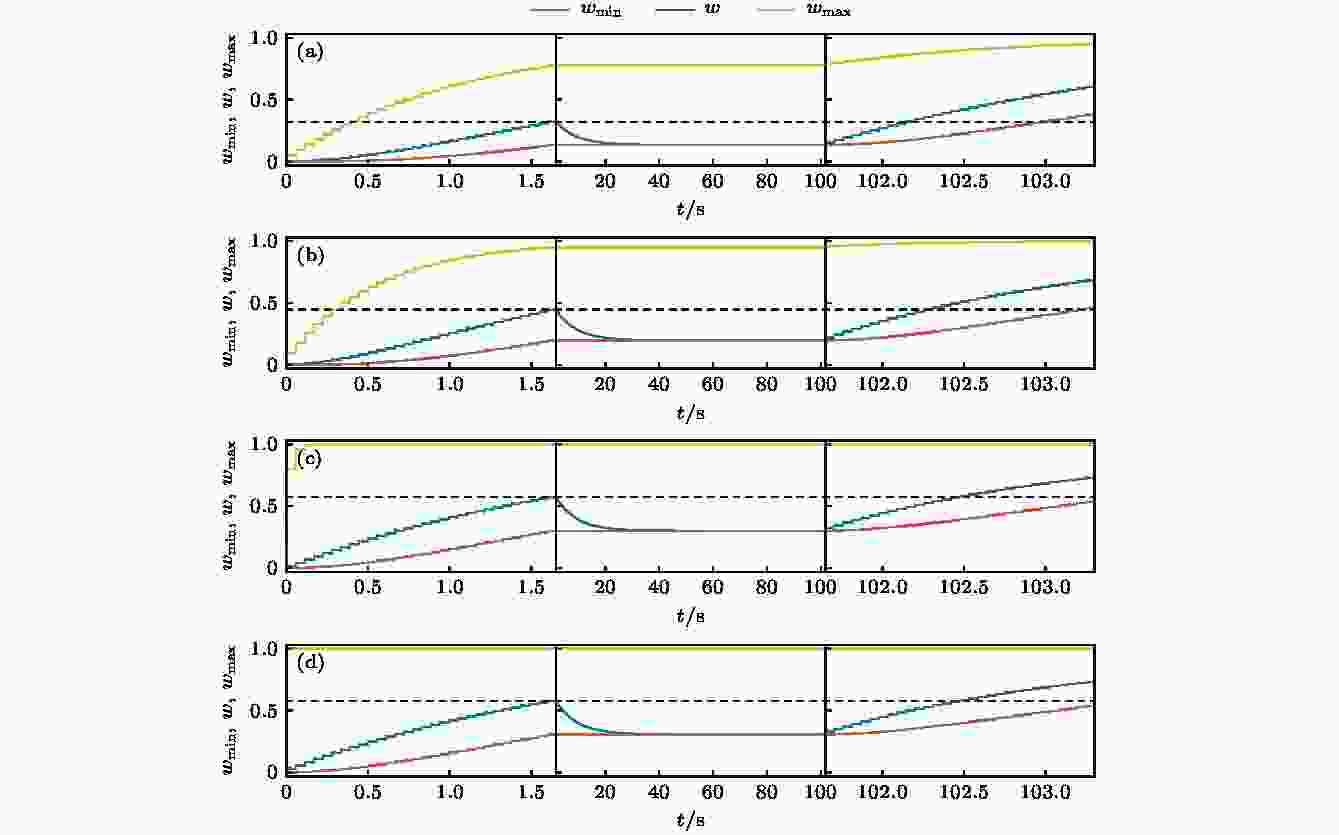 图 7 τw+ = 0.15 s, τmin+ = 0.1 s, τmax+取不同值时的“学习-遗忘-再学习”实验仿真结果 (a) τmax+ = 0.1 s; (b) τmax+ = 0.05 s; (c) τmax+ = 0.003 s; (d) 当wmax为常数1, 模型其他参数与(a)?(c)相同时的“学习-遗忘-再学习”实验仿真结果. 虚线标出w在初次学习阶段所达到的最大值
图 7 τw+ = 0.15 s, τmin+ = 0.1 s, τmax+取不同值时的“学习-遗忘-再学习”实验仿真结果 (a) τmax+ = 0.1 s; (b) τmax+ = 0.05 s; (c) τmax+ = 0.003 s; (d) 当wmax为常数1, 模型其他参数与(a)?(c)相同时的“学习-遗忘-再学习”实验仿真结果. 虚线标出w在初次学习阶段所达到的最大值Figure7. Simulations of “learning-forgetting-relearning” process when τw+ = 0.15 s, τmin+ = 0.1 s, and τmax+ takes different values: (a) τmax+ = 0.1 s; (b) τmax+ = 0.05 s; (c) τmax+ = 0.003 s; (d) simulation of “learning-forgetting-relearning” process when wmax = 1, and other parameters are the same as those used in (a)?(c). The maximum value of w during the first learning period is marked by a dashed line.
参数τmin+描述了wmin在脉冲激励作用时的最大增速: 当其他参数一定时, τmin+越小, wmin在脉冲激励作用时的增长越快. 图5给出τw+ = 0.06 s, τmax+ = 0.05 s, τmin+取不同值时的“学习-遗忘-再学习”实验仿真结果. 在初次学习阶段, τmin+取值的不同会对wmin的增速有明显影响, 而对于w和wmax的增长速度影响并不明显. 在之后的遗忘阶段, wmin和wmax基本保持不变, w将逐渐递减并收敛于wmin. 由于τmin+取不同值时在初次学习阶段wmin的增量不同, 因此在遗忘阶段w的收敛值以及在再学习阶段的记忆恢复所需的脉冲数量也有相应的区别: τmin+取值分别为0.5, 0.2和0.1 s时, 记忆恢复所经历的脉冲数量分别为16, 14和12个.
参数τw+描述了w在脉冲作用时的最大增长速度: 当其他参数一定时, τw+越小, w在脉冲激励作用时的增长越快. 图6给出τmin+ = 0.2 s, τmax+ = 0.1 s, τw+取不同值时的“学习-遗忘-再学习”实验仿真结果. 在初次学习阶段, τw+越小, 则w的增长过程越接近于其上限wmax的增长过程; τw+的大小对于wmax的变化速度并无明显影响; w限制了wmin的变化上限, 当w增长速度变快时, wmin的增速也会有所增长, 因此τw+的减小也会使得w在遗忘过程的收敛值增大. 在再次学习阶段, 当τw+取值分别为0.15和0.06 s时, 如图6(a)和图6(b)所示, 完成记忆恢复需分别经历12和11次脉冲激励, 记忆恢复前后脉冲作用下的记忆增速无明显变化; 当τw+ = 0.01 s时, 如图6(c)所示, 仅经历5次脉冲激励后就可使得w恢复在初次学习中所达到的最大值, 在之后的脉冲激励作用下w将跟随wmax逐渐增长, 脉冲作用下的记忆增速在记忆恢复之后明显比记忆恢复阶段更小. 文献[21,30]中报道了再学习阶段记忆恢复后脉冲继续作用下的记忆增长情况: 文献[21]所报道的实验现象中, 再学习阶段记忆恢复速度比初次学习的记忆增速快得多, 在记忆恢复后记忆的增速会有明显的减慢, 减慢后的记忆增速与初次学习的记忆增速相似; 文献[30]中的忆阻器在再学习阶段的记忆恢复速度略快于初次学习的记忆增速, 记忆恢复后脉冲继续作用下的记忆增速并无明显变化. 由图6所示仿真过程可知, 这两种情况的实验现象可通过调整参数τw+的大小来描述.
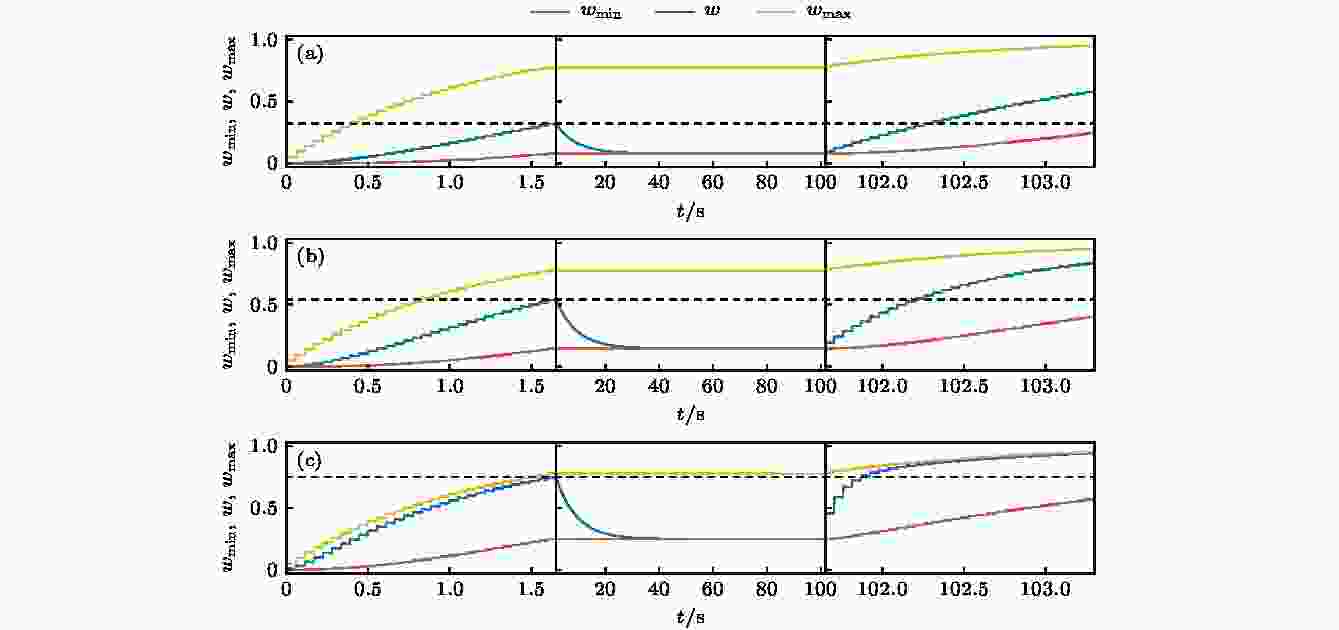 图 6 τmin+ = 0.2 s, τmax+ = 0.1 s, τw+取不同值时的“学习-遗忘-再学习”实验仿真结果 (a) τw+ = 0.15 s; (b) τw+ = 0.06 s; (c) τw+ = 0.01 s. 虚线标出w在初次学习阶段所达到的最大值
图 6 τmin+ = 0.2 s, τmax+ = 0.1 s, τw+取不同值时的“学习-遗忘-再学习”实验仿真结果 (a) τw+ = 0.15 s; (b) τw+ = 0.06 s; (c) τw+ = 0.01 s. 虚线标出w在初次学习阶段所达到的最大值Figure6. Simulations of “learning-forgetting-relearning” process when τmin+ = 0.2 s, τmax+ = 0.1 s, and τw+ takes different values: (a) τw+ = 0.15 s; (b) τw+ = 0.06 s; (c) τw+ = 0.01 s. The maximum value of w during the first learning period is marked by a dashed line.
参数τmax+描述了wmax在脉冲激励作用时的增速: τmax+越小, wmax在脉冲激励作用时的增长越快; wmax限定了w的上限, wmax增速加快也会使得w和wmin的增速加快. 图7(a)—(c)给出τmin+ = 0.1 s, τw+ = 0.15 s, τmax+取不同值时的“学习-遗忘-再学习”实验仿真结果. τmax+的减小使得状态变量wmax, w, wmin在初次学习阶段的增长速度均明显加快. τmax+取值分别为0.1, 0.05和0.003 s时, 再学习过程中记忆恢复所经历的脉冲数量分别为10, 12和16. 由图7(c)的仿真结果可以看出, 当wmax在脉冲作用下的增速非常快时, 记忆恢复过程的脉冲数量减少主要是因为wmin在初次学习阶段的增长使得再学习阶段w的初值较大, 遗忘前后w在脉冲作用时的增速已无明显变化; 图7(d)给出wmax = 1、模型其他参数与图7(a)—(c)相同时的“学习-遗忘-再学习”实验仿真结果, 状态变量w和wmin在图7(d)与图7(c)所示过程中的变化情况非常相似, 因此状态变量wmax在脉冲作用下的增速远比w更快时的经验学习特性接近于上一节中所讨论的较快速再次学习特性.
文献[36]对模型状态变量w, wmin, τw 0的物理意义已给出讨论: w描述了导电通道的归一化面积, wmin描述了导电通道稳定部分的归一化面积, τw 0描述了在移除脉冲电压后导电通道不稳定部分消失的快慢. 在一段时间内, 只有位于导电通道周围的离子(或空穴)在外加脉冲电压作用下可参与进一步形成更多的导电通道, 即在这段时间内可形成的导电通道的大小存在一个上限, 具有经验学习特性的忆阻模型中, 状态变量wmax即描述了当前时刻可形成的导电通道的归一化面积的上限. 这里将一段时间内可运动至导电通道附近并参与形成导电通道的离子(或空穴)所分部的区域称为导电通道的周围区域.
图8给出“学习-遗忘-再学习”实验中导电通道及其周围区域在外加电压作用下的变化情况. 在初次学习阶段, 如图8(a)所示, 连续的脉冲激励作用下不断有更多的离子(或空穴)逐渐移动至导电通道的周围区域, 并参与形成连通两电极的导电通道, 导电通道及其周围区域均逐渐增宽, 并且导电通道中有更多的不稳定部分逐渐变为稳定部分, 在这一阶段模型状态变量w, wmax, wmin均逐渐增大; 在遗忘阶段, 如图8(b)所示, 导电通道的不稳定部分逐渐分解消失, 构成这部分导电通道的离子(或空穴)在离开导电通道后仍然分布在导电通道的周围区域, 因此经历遗忘过程之后, 连接两电极的导电通道的宽度减小, 而导电通道的稳定部分以及导电通道的周围区域的大小基本不变, 在这一过程中模型状态变量w减小至wmin, 而wmin和wmax基本不变; 在之后的再次学习阶段, 如图8(c)所示, 由于导电通道的周围区域之中存在大量的离子(或空穴), 在脉冲电压作用下导电通道将快速恢复到遗忘之前的宽度, 之后以类似初次学习阶段的速度逐渐增宽, 这一过程中w首先快速增长回到遗忘之前的状态, 当w接近于wmax时, w跟随wmax逐渐增长.
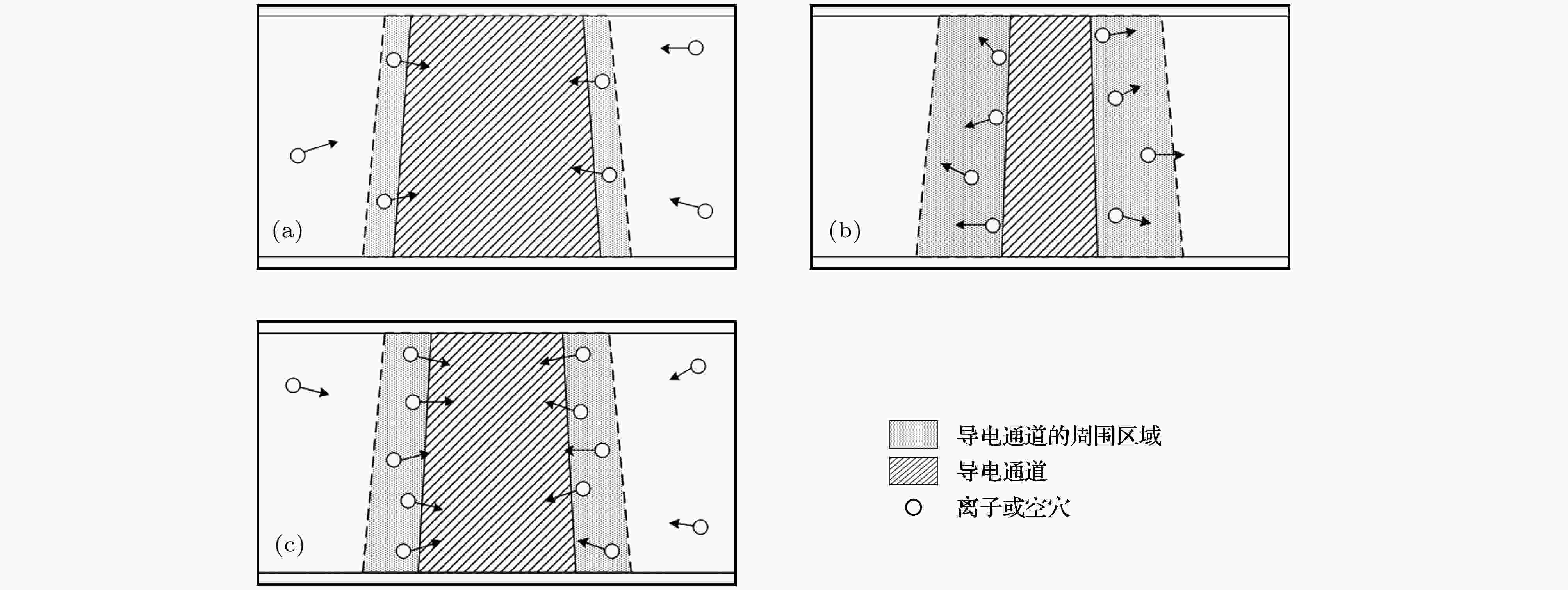 图 8 忆阻器两电极间导电通道及其周围区域在“学习-遗忘-再学习”实验中的变化情况 (a) 初次学习阶段; (b) 遗忘阶段; (c) 再次学习的记忆恢复阶段
图 8 忆阻器两电极间导电通道及其周围区域在“学习-遗忘-再学习”实验中的变化情况 (a) 初次学习阶段; (b) 遗忘阶段; (c) 再次学习的记忆恢复阶段Figure8. Change of the conductive channel and its surrounding area during different periods of the “learning-forgetting-relearning” process: (a) The first learning process; (b) the forgetting process; (c) the memory recovery period of the relearning process.
模型中的参数τmin+, τw+, τmax+分别描述了导电通道的稳定部分、导电通道、导电通道的周围区域这三个部分在脉冲电压作用时的增长速度: τmin+越小, 则在脉冲电压作用下导电通道的不稳定部分变为稳定部分的速度越快; τw+越小, 则位于导电通道周围区域的离子(或空穴)在脉冲电压作用下形成导电通道的速度越快; τmax+越小, 则脉冲电压作用下离子(或空穴)运动进入导电通道的周围区域的速度越快. 若τmax+的取值接近其下限0, 则脉冲电压作用时导电通道的周围总是存在充足的离子(或空穴), 此时导电通道在脉冲电压作用时的增长过程不会明显受到离子(或空穴)分布情况的限制; 在脉冲间隔期间, 导电通道不稳定部分的分解速度仍然会随着所经历的脉冲数量的增多而逐渐减慢. 此时忆阻器在“学习-遗忘-再学习”实验中表现接近于较快速再次学习特性.
